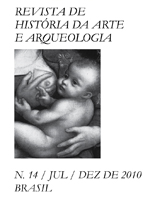Abstract
This article aims to present the latest research carried out with the Archaeological Site Córrego da Lagoa 2, located in the city Altônia (PR), relating artwork to pottery found in these other studies that also sought to understand the art among the indigenous
Tupi language trunk. We seek to present the history of the site, the organization of the archives and some issues relating to indigenous art and designs.
References
ELLI, Francisco Silva. Sem tekohá não há tekó (em busca de um modelo etnoarqueológico da aldeia e da subsistência Guarani e sua aplicação a uma área de domínio no Delta do Rio Jacuí (RS), Dissertação de Mestrado, PUCRS, Porto Alegre, 1993.
FERNANDES, Florestan. Organização social do tupinambá. São Paulo: Corpo e alma do Brasil, 1963.
OLIVEIRA, Kelly. Estudando a cerâmica pintada da tradição Tupiguarani: a coleção Itapiranga, Santa Catarina. Dissertação de Mestrado, PUCRS, Porto Alegre, 2008.
PROUS, André. “A pintura em cerâmica guarani.” Ciência Hoje, v. 36, n. 213, mar. 2005, p. 22-28.
PROUS, André. Arqueologia brasileira. Brasília, DF: Editora Universidade de Brasília, 1992.
SIMÃO, Ana Paula. Do caco ao fragmento: análise da coleção cerâmica guarani do sítio arqueológico Lagoa Xambrê - Altônia/PR. Dissertação de Mestrado, Maringá, 2002.
VIDAL, Lux. “Antropologia estética: enfoques teóricos e contribuições metodológicas”. In: VIDAL, Lux (org.). Grafismo indígena. São Paulo: EDUSP.

This work is licensed under a Creative Commons Attribution 4.0 International License.
Copyright (c) 2021 Journal of Art History and Culture

